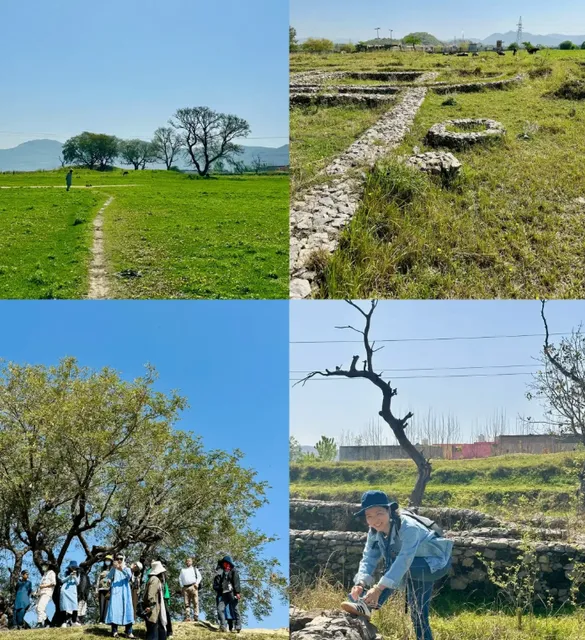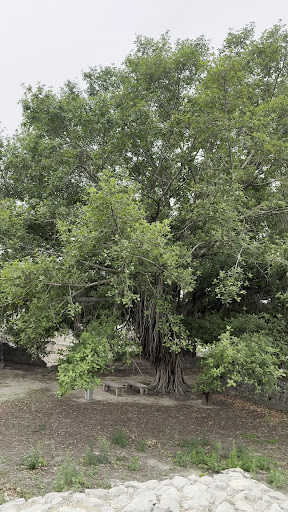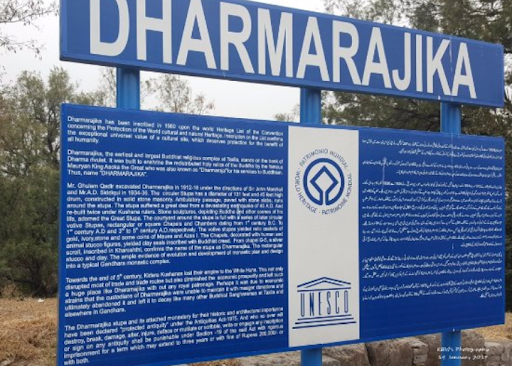The oldest and largest Buddhist complex of Dharmarajika stupa or locally known as Chir Tope, is located on an eastern route along the Tamra stream, south of Hathial, about three kilometers from Taxila Museum. The origin of the name Dharmarajika lies in the fact that the stupa was erected over the body relics of Gautama Buddha, the true Dharmaraja. Taxila was one of the many cities in the Maurya Empire which received a share of the holy relics from Ashoka. The Dharmarajika Stupa was erected by Ashoka himself to enshrine the relics share.
The Dharmarajika complex covers almost the entire period of the history of Buddhism in Taxila from 3rd century BCE to 7th century CE. The main stupa was constructed during the Mauryan period but suffered after an earthquake in 40 CE. It was rebuilt twice in the Kushana period. The whole complex at the Dharmarajika falls into two parts; the first part comprises a medley of constructions of several types and is called the stupa area; and the second part, which is located to its north, is called the monastic area.
The main stupa is built in a circular plan, with a 131 feet wide diameter and a 45 feet high drum. The stupa is constructed in solid masonry and has a raised terrace around its base which was ascended by four flights of steps. The structure is surrounded by an open paved passage, which served in ancient days as a procession path. The courtyard of the stupa area is further bordered by numerous other chapels and several votive stupas, erected by the pilgrims and visitors, dating from 1st century BCE to 1st century CE and from 3rd to 5th century CE, respectively. These stupas were decorated with Buddha images and figurines. To the north of the great stupa lie the monastic area which formed the living quarters and workspaces for monks.
Several objects have been excavated from Dharmarajika Stupa, all of which have been preserved and displayed at Taxila Museum. Among these the most remarkable finding was that of a reliquary in one of the side chapels containing a silver scroll, which records the enshrinement of Buddha relics at Dharmarajika Stupa. In 1917 a casket was found here which contained the relics of Lord Buddha. This was presented by the then viceroy of British India to the Buddhists Community of Ceylon and has since been enshrined in the Temple of Tooth at Kandy city in Sri Lanka.
Dharmarajika was excavated in 1912 - 1916 by Mr. Ghulam Qadir under the directions of Sir John Marshall and in 1934 - 1936 by Mr. A.D. Siddiqui. In 1980, it was included in the World Heritage List by UNESCO for having cultural, historical, scientific or other form of...
Read moreThe Dharmarajika Stupa, located in Taxila, Pakistan, is one of the oldest Buddhist religious complexes in South Asia, dating back to the 3rd century BCE. It was built by the Mauryan emperor Ashoka the Great, who embraced Buddhism after the Kalinga War and became its chief patron. The site was named “Dharmarajika”, meaning “Realm of Dharma (Law),” a title associated with Ashoka himself.
This stupa was constructed to enshrine relics of the Buddha, possibly including his ashes, making it a revered pilgrimage site. The original mound was a simple hemispherical dome, but over centuries, it was expanded and surrounded by numerous smaller stupas and monasteries. The flourishing of the Dharmarajika complex is closely linked to the Gandhara civilization, which blended Hellenistic and Indian art styles.
During the Kushan period (1st–3rd century CE), the complex saw its golden age. Under rulers like Kanishka, it became a center of Buddhist learning, sculpture, and architecture. Intricate stone carvings, images of the Buddha, and decorative reliefs reflect the sophisticated Gandharan style that thrived here.
By the 5th century CE, however, Dharmarajika began to decline. The invasion of the Huns, led by White Huns (Hephthalites) in the 5th–6th century, led to the destruction of many Buddhist sites in the region. The complex was eventually abandoned.
Archaeological excavations in the 20th century unearthed the main stupa, votive stupas, monasteries, coins, inscriptions, and Buddhist relics. Many of these artifacts are preserved in the Taxila Museum.
Today, the Dharmarajika Stupa stands as a UNESCO World Heritage Site and a symbol of Pakistan’s ancient Buddhist heritage, attracting historians, archaeologists, and visitors from around the world interested in the legacy of early Buddhism and...
Read moreThe Dharmarajika Stupa is one of the oldest and most important Buddhist stupas in India. It is located in the city of Taxila, which is now in Pakistan, and is believed to have been built during the Mauryan period, around the 3rd century BCE.
The stupa was originally constructed by Emperor Ashoka, who was a patron of Buddhism and had a number of important Buddhist sites built throughout his empire. The Dharmarajika Stupa was one of the earliest, and it was built to enshrine the relics of the Buddha that had been collected by his disciples after his death.
The stupa was originally a simple brick structure, but it was later enlarged and embellished by various rulers over the centuries. It is now a complex of ruins, with several different structures and monuments scattered throughout the area.
One of the most impressive features of the Dharmarajika Stupa is the Ashoka Pillar, which is located near the entrance to the stupa complex. This pillar is made of polished sandstone and is about 12 meters tall. It is topped by a capital in the shape of four lions, which has become one of the most famous symbols of India.
The Dharmarajika Stupa is an important pilgrimage site for Buddhists, and it continues to be visited by people from all over the world who come to pay their respects to the Buddha and to learn more about the history of...
Read more


